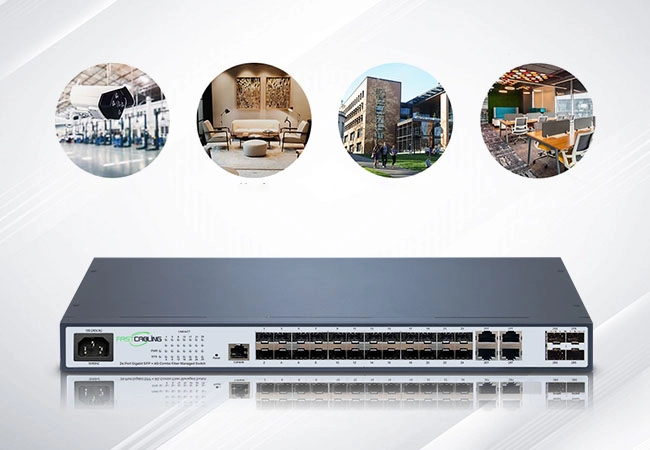Picture this: a group of musicians gathered in a cramped music room, trying to collaborate on a new piece of music. Frustration sets in as they struggle to communicate effectively, and the quality of their audio suffers.
In the midst of this chaos, you may find yourself wondering why they don’t have a network switch.
While it may seem like a small detail, a network switch can make all the difference in a music room. Not only does it improve communication between devices, but it also enhances audio quality and seamlessly integrates with digital audio workstations.
In this article, we will explore the reasons why a music room should have a network switch, from increased flexibility and expandability to enhanced collaboration and sharing capabilities. So, if you’re a musician looking to take your music to the next level, read on to discover the Benefits of having Network Switches for your music room.
Key Takeaways
- A network switch in a music room improves communication, audio quality, and security of the network.
- It reduces the need for multiple cables and devices, prioritizes audio traffic to reduce dropouts, and increases flexibility and expandability of the music production setup.
- A network switch enhances collaboration and sharing capabilities, provides efficient and flexible workflow, and seamlessly integrates with digital audio workstations.
- It acts as a central hub for all connected devices, transmits audio signal directly from source to receiver without interference or delay, and provides a better experience for performers and listeners. It is also cost-effective with good ROI and an essential step towards efficient and secure communication between devices.
Faster and More Efficient Communication between Devices
The installation of a network switch in a music room facilitates faster and more efficient communication between devices, enabling seamless transmission of audio and video data across the network.
A network switch is a central device that connects multiple devices in a network, allowing them to communicate with each other.
With a network switch, multiple devices such as computers, audio interfaces, and speakers can be connected to the same network, ensuring that all devices are interconnected and can communicate with each other.
This not only improves the efficiency of communication between devices but also enhances the security of the network.
It also ensures cost-effectiveness and ROI, as it reduces the need for multiple cables and devices, leading to a streamlined setup and reduced maintenance costs.
Therefore, the implementation of a network switch in a music room is an essential step towards efficient and secure communication between devices, leading to a more productive and cost-effective setup.
Improved Audio Quality
Enhanced auditory acuity is achievable through the installation of a networking device in the sound studio.
By using a network switch, the audio signal can be transmitted with minimal latency, resulting in improved audio quality.
The network switch acts as a central hub for all connected devices, reducing the need for manual routing and signal processing.
This means that the audio signal can be transmitted directly from the source to the receiver without any interference or delay.
Additionally, the network switch can prioritize audio traffic, ensuring that important audio signals are transmitted first.
This reduces the risk of audio dropouts, which can be a common problem in large sound studios.
Overall, the installation of a network switch in the music room can significantly improve the quality and reliability of audio transmission, providing a better experience for both the performer and the listener.
Seamless Integration with Digital Audio Workstations
Optimizing the integration between digital audio workstations and other equipment in a music room can enhance workflow efficiency and increase creative possibilities.
With the use of a network switch, real-time synchronization between multiple workstations can be achieved, allowing for seamless collaboration among musicians and producers. This feature eliminates the need for transferring files manually, saving time and effort.
Additionally, a network switch enables remote accessibility, allowing users to access and control audio equipment from different locations. This feature can be especially useful for remote recording sessions or virtual collaborations.
With the ability to seamlessly integrate with digital audio workstations, a network switch can provide a more efficient and flexible workflow, ultimately enhancing the quality of music production in a music room.
Increased Flexibility and Expandability
By providing the ability to connect and control multiple devices simultaneously, a well-designed network switch can significantly increase the flexibility and expandability of a music production setup.
Equipment compatibility is a crucial aspect of any music production setup, and a network switch plays a vital role in ensuring that all devices work together seamlessly. With a network switch, it becomes possible to connect multiple devices to a single interface, making it easier to manage and control the entire setup.
Additionally, scalability is an essential feature of a music production setup, and a network switch can help scale up the system as necessary. This allows music producers to add new equipment to their setup without worrying about compatibility issues or the need for additional hardware.
Overall, a network switch is an invaluable tool for any music production setup looking to increase its flexibility and expandability.
Enhanced Collaboration and Sharing Capabilities
The advanced collaboration and sharing capabilities facilitated by a well-designed network switch can foster a sense of community and creative camaraderie among music producers, inspiring them to push boundaries and create innovative works of art.
Real-time feedback is a key feature that enables musicians to interact with each other in a seamless and efficient manner, allowing them to make real-time adjustments and improvements to their music.
Remote access is another important aspect of enhanced collaboration and sharing capabilities, as it enables musicians to work together from different locations and share their musical creations with each other, regardless of where they are in the world.
With a network switch, musicians can collaborate and share their work in a more efficient and effective way, which can lead to greater innovation and creativity in the music industry.
Conclusion
The implementation of a network switch in a music room yields numerous benefits, including faster and more efficient communication between devices, improved audio quality, seamless integration with digital audio workstations, increased flexibility and expandability, as well as enhanced collaboration and sharing capabilities.
With the aid of a network switch, music production can be streamlined and made more efficient, allowing for greater creativity and productivity.
Moreover, according to a recent study, the use of a network switch in a music production environment can significantly reduce latency and improve overall audio quality. This is achieved by ensuring that all devices are connected to a centralized network, which in turn eliminates the need for multiple connections and improves communication between devices.
The result is a seamless and efficient music production process that is free from interference and latency issues.
In conclusion, the use of a network switch in a music room is a necessary and essential tool for any serious music producer. The benefits of implementing a network switch are numerous, and the increased efficiency and productivity that it offers cannot be overstated. With the aid of a network switch, musicians and producers can take their music production to the next level, and create high-quality music that is free from latency and interference.
You may also like to read:
HOW TO UPDATE YOUR RECORDING STUDIOS TO GET THE MUSICAL FEEL?






